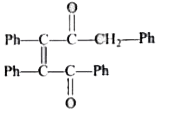Consider the following reaction (A)(i)O3−−−−−−−→(ii)H2O/ZnCH3−O∣∣C−CH2−O∣∣C−CH2−O∣∣C−CH3+3HCHO Compound 'A' will be
CH3−O∣∣C−CH2−O∣∣C−CH2−CH2∣∣C−CH3
CH3−O∣∣C−CH2−CH2∣∣C−CH2−O∣∣C−CH3
CH3−CH2∣∣C−CH2−CH2∣∣C−CH2−C∣CH3=CH2
All of these
The correct Answer is:C
To determine the compound 'A' in the given reaction, we need to analyze the process of reductive ozonolysis and how it affects alkenes. Here’s a step-by-step breakdown of the solution:
1. Understanding Reductive Ozonolysis:
- Reductive ozonolysis involves the reaction of an alkene with ozone (O₃) followed by reduction (usually with zinc and water). This reaction cleaves the double bond of the alkene and forms carbonyl compounds (aldehydes and/or ketones).
2. Analyzing the Products:
- The reaction produces a ketone and 3 moles of formaldehyde (HCHO). The presence of 3 moles of formaldehyde indicates that the original compound must have 3 terminal methylene groups (–CH₂–) adjacent to the double bonds.
3. Identifying the Structure of Compound 'A':
- Since we have 3 moles of formaldehyde formed, it suggests that the original compound 'A' must be a symmetrical alkene with three double bonds that can yield formaldehyde upon ozonolysis.
- The structure of compound 'A' can be inferred to be an alkene with the following structure:
CH3−CH=CH−CH2−CH=CH−CH2−CH=CH−CH3
- This structure has three double bonds, and when ozonolysis occurs, it will yield three formaldehyde molecules and one ketone.
4. Performing the Ozonolysis:
- When ozonolysis occurs on this compound, the double bonds will break, leading to the formation of three formaldehyde molecules and a ketone. The ketone will have the structure:
CH3−C(=O)−CH2−C(=O)−CH2−C(=O)−CH3
- This confirms that the original compound 'A' is indeed the alkene with three double bonds.
5. Conclusion:
- Therefore, compound 'A' is the symmetrical alkene that upon ozonolysis produces the specified ketone and three moles of formaldehyde.
Final Answer:
Compound 'A' is:
CH3−CH=CH−CH2−CH=CH−CH2−CH=CH−CH3
- Reductive ozonolysis involves the reaction of an alkene with ozone (O₃) followed by reduction (usually with zinc and water). This reaction cleaves the double bond of the alkene and forms carbonyl compounds (aldehydes and/or ketones).
- The reaction produces a ketone and 3 moles of formaldehyde (HCHO). The presence of 3 moles of formaldehyde indicates that the original compound must have 3 terminal methylene groups (–CH₂–) adjacent to the double bonds.
- Since we have 3 moles of formaldehyde formed, it suggests that the original compound 'A' must be a symmetrical alkene with three double bonds that can yield formaldehyde upon ozonolysis.
- The structure of compound 'A' can be inferred to be an alkene with the following structure:
CH3−CH=CH−CH2−CH=CH−CH2−CH=CH−CH3
- This structure has three double bonds, and when ozonolysis occurs, it will yield three formaldehyde molecules and one ketone.
- When ozonolysis occurs on this compound, the double bonds will break, leading to the formation of three formaldehyde molecules and a ketone. The ketone will have the structure:
CH3−C(=O)−CH2−C(=O)−CH2−C(=O)−CH3
- This confirms that the original compound 'A' is indeed the alkene with three double bonds.
- Therefore, compound 'A' is the symmetrical alkene that upon ozonolysis produces the specified ketone and three moles of formaldehyde.
Compound 'A' is:
CH3−CH=CH−CH2−CH=CH−CH2−CH=CH−CH3
Similar Questions
Knowledge Check
The IUPAC name ofCH3−OH∣C∣H−CH2−O∣∣C−CH3 is
A2-Hydroxypentan-4-oneB4-Hydroxypentan-2-oneC4-oxopentan-2-olD2-oxopentan-4-olFind the product of following reaction:
Ph−CH2−O∣∣C−CH2−Ph+Ph−O∣∣C−O∣∣C−PhNaOH−−−−−−→ΔA B
B C
C DNone of these
DNone of theseAn unknown alkene (A) reacts with 3 mole of H2 gas in presence of platinum catalyst to form 1-isopropyl-4-methyl cyclohexane. When unknown alkene (A) is ozonized and reduced, following product are obtained
H−O∣∣C−H H−O∣∣C−CH2−O∣∣−O∣∣C−CH3, CH3−O∣∣C−CH2−O∣∣C−H
The alkene (A) is :A B
B C
C D
D
The order of stability of the following tautomeric compounds is
(i). CH2=OH∣CH−CH2−O∣∣C−CH3⇔
(ii). CH3−O∣∣C−CH2−O∣∣C−CH3⇔
(iii). CH3−OH∣C=CH−O∣∣C−CH3
View SolutionThe order of stability of the following tautomeric compounds is
(i). CH2=OH∣CH−CH2−O∣∣C−CH3⇔
(ii). CH3−O∣∣C−CH2−O∣∣C−CH3⇔
(iii). CH3−OH∣C=CH−O∣∣C−CH3
View SolutionThe following carbocation rearranges to
CH2=C∣CH3−CH3∣C−⊕CH−CH3∣CH−CH3
View SolutionThe IUPAC name for CH3−O∣∣C−CH2−CH2−O∣∣C−OH is ______.
View SolutionCH3−O∣∣C−H and Ph−O∣∣C−H can be differentiated by :
View Solution
